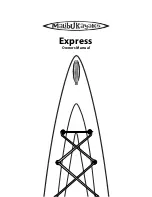
1. Helm
•
Look around to know where mark is and which
boats will have rights or give room.
•
Bring bow down the required amount for the
conditions.
•
Look for the mark again and work out which boats
to steer around.
•
Execute a nice wide-and-tight turn, trying not to
park the boat up but let it accelerate into and out
of the turn.
2. Tactician
•
Communicate type of drop exit and the plan out of
the mark.
•
Count down the drop.
•
If not going to left (port) turn, wind runner up
before mark to be about 80-90 percent tension.
•
If jibing, ease runner off or bring on new runner. In
light air, do both runners.
3. Main
•
Set up main for the beat.
•
Have both mainsheet winches ready to be ground in.
4. Trimmer
•
Ease spinnaker sheet at the count of 2, then stand
by to overhaul sheets out of the water.
•
Load jib onto winch and prepare to trim on or jibe
the jib.
•
Move up to windward side and load new sheet.
•
Start talking with helm about feel and speed/
angles to sail.
5. Trim #2
•
Pull pole in on Bow’s call.
•
Get tail of jib sheet to tail in for Trimmer while
hitting the rail.
6. Pit
•
Set up outhaul and cunningham.
•
Make sure jib halyard is at its mark for the beat.
•
Blow the tack jammer (first) and halyard jammer
(second) on the drop call.
•
Follow the drop and be ready to check the halyard
on the way down.
•
Once clean and clear, hit the rail with vang in hand.
7. Mast
•
Stand in cockpit with feet on back of
companionway, ready to pull chute down with
string line. Pull out all slack during countdown.
Once chute is all the way in, throw string line
forward to front of cockpit and hit the rail.
8. Bow
•
Be on your feet and able to move around the
hatch.
•
Make sure string line is above headstay and pulling
high.
•
Open hatch and make sure lazy sheet is over hatch
and set up for the drop.
•
Be ready to start pulling on string line until cloth of
sail is reached, then work tack inside and under the
jib, then work the clew and head while going up
the sail stuffing all parts down as it’s pulled in.
•
Clean up and close hatch; check to see if jib needs
skirting.
•
Windward drop allows Bow to bring halyard aft
with them and clip it to keeper as they hit the rail
and start hiking.
9. Floater
•
When windy, stay back and help set up the
runners.
•
If jibing to mark, release old runner or bring on
new runner.
•
Hit the rail and start hiking.
Mexican / Kiwi Drop
As it gets windier, this drop becomes an early-leeward-
drop-turning-into-a-Mexican. The dial-down of the
bow remains important to help stand the boat up and
limit the load and bow waves. The countdown “5, 4, 3,
2, 1, drop!” is vital for the Helm, Trimmer and Pit. The
Mast will be taking up tension on the takedown string
line to beat the whole drop process. On the “3,” the
bow comes down, on “2,” the sheet is eased, then a
combination of halyard (first) and tack (second) at the
drop call. With the countdown at 1, start to open the
jammer (clutch) ready for the drop call.
Содержание IC37
Страница 1: ...Sailing Manual 1 0...
Страница 2: ......
Страница 18: ...12 Knot Configuration Light Air Configuration...
Страница 19: ...Drifting Configuration...
Страница 20: ...northsails com...





































